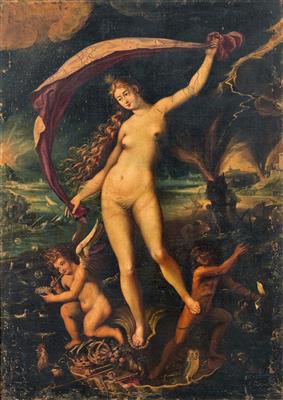School of Prague (?), 17th Century

Allegory of fortune and human fragility,
inscribed on the shell: NE CEDAS:ARDVVM PARARE,
oil on canvas, 138 x 98 cm, framed
The present painting shows a complex allegory on the fragility of human life, and its dangers. The female figure represents the personification of Fortune. She rests one foot on a shell on which we can read the Latin inscription 'ne cedas: arduum parare' - an encouraging spur to prepare for the difficulties of life thrown up by fate.
Each object in this painting hides a symbolic meaning, which, for modern viewers, is often difficult to decipher fully. The cockerel and the owl for example allude to day and night, and therefore to the passing of time which is also represented by the hourglass, while all the precious objects contained in the shell refer to the vanity of earthly things: of power and wealth that are exposed to the unpredictable aspects of fortune. The brevity of our earthly existence is also recalled by the soap bubbles being blown by the putto on the left, and two of these are notably inscribed 'nihil' and 'denique', indicating that 'at the end there is nothing'.
Even the images in the background, like the great fire and the lightning bolt, are an admonishment to the spectator against the dangers that threaten existence.
This allegorical composition with a series of symbols accords with the erudite taste of the European courts of the sixteenth and seventeenth centuries, and especially those of Central Europe.
11.12.2018 - 14:00
- Odhadní cena:
-
EUR 15.000,- do EUR 20.000,-
School of Prague (?), 17th Century
Allegory of fortune and human fragility,
inscribed on the shell: NE CEDAS:ARDVVM PARARE,
oil on canvas, 138 x 98 cm, framed
The present painting shows a complex allegory on the fragility of human life, and its dangers. The female figure represents the personification of Fortune. She rests one foot on a shell on which we can read the Latin inscription 'ne cedas: arduum parare' - an encouraging spur to prepare for the difficulties of life thrown up by fate.
Each object in this painting hides a symbolic meaning, which, for modern viewers, is often difficult to decipher fully. The cockerel and the owl for example allude to day and night, and therefore to the passing of time which is also represented by the hourglass, while all the precious objects contained in the shell refer to the vanity of earthly things: of power and wealth that are exposed to the unpredictable aspects of fortune. The brevity of our earthly existence is also recalled by the soap bubbles being blown by the putto on the left, and two of these are notably inscribed 'nihil' and 'denique', indicating that 'at the end there is nothing'.
Even the images in the background, like the great fire and the lightning bolt, are an admonishment to the spectator against the dangers that threaten existence.
This allegorical composition with a series of symbols accords with the erudite taste of the European courts of the sixteenth and seventeenth centuries, and especially those of Central Europe.
|
Horká linka kupujících
Po-Pá: 10.00 - 17.00
old.masters@dorotheum.at +43 1 515 60 403 |
| Aukce: | Obrazy starých mistrů |
| Typ aukce: | Salónní aukce |
| Datum: | 11.12.2018 - 14:00 |
| Místo konání aukce: | Wien | Palais Dorotheum |
| Prohlídka: | 06.12. - 11.12.2018 |
